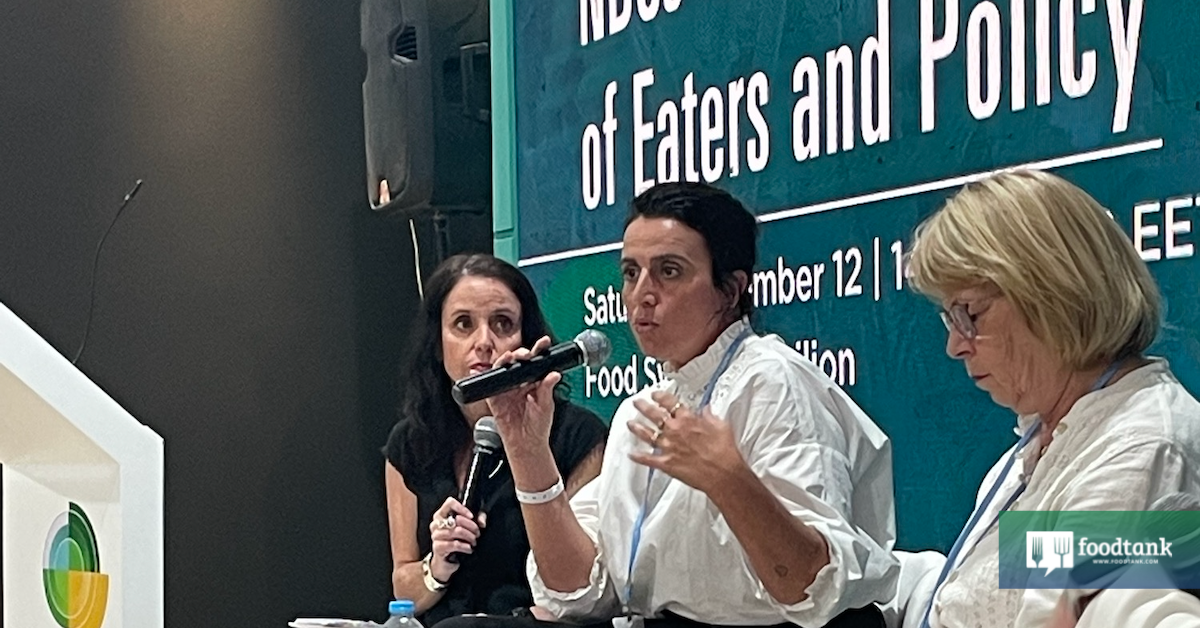
During a recent session at the U.N. Climate Change Conference, food systems leaders discussed the ways food and agriculture systems can help countries achieve climate goals while meeting the needs of eaters and policy. The conversation was organized by Food Tank in partnership with the Food Systems Pavilion at COP27.
Food and agriculture systems account for roughly one third of global greenhouse gas emissions. This includes the ways the world produces, processes, transports, and consumes food. But as recently as 2020, few parties that signed the Paris Agreement incorporated food systems into their Nationally Determined Contributions (NDCs), says Martina Fleckenstein, Global Policy Director for Food at WWF International.
Some NDCs — which refer to national action plans to reduce greenhouse gas emissions and adapt to impacts of the climate crisis — incorporated food production. Far fewer addressed consumption.
Fleckenstein notes that fortunately, this is beginning to change: “At least 93 percent of member states are mentioning food somehow…in their NDCs.”
This new trend is important, panelists argue. “We should not be waiting for a crisis to discuss food and agriculture and linkages to climate and other issues,” says Saswati Bora, Global Director of Regenerative Food Systems for The Nature Conservancy. She believes that the NDCs present a great opportunity to do this, allowing stakeholders to evaluate government commitments and measure progress over time.
But speakers including Fleckenstein and Bora also say that the development of more holistic NDCs is still required, with issues such as food loss and waste and sustainable diets often left out of the conversation.
“We’re all working in siloes in parallel instead of actually working together,” says Lee Recht, Vice President of Sustainability for Aleph Farms.
Agroecology, if properly incorporated into national action plans, offers one avenue to address these needs, says Million Belay, General Coordinator for the Alliance for Food Sovereignty in Africa. This holistic approach to agriculture is “based on enriching the soil, bringing the communities together, planting diverse crops, and basing future initiatives on the culture and practices of people.”
Implementing solutions to drive this transition, however, will require funding. And currently, just 3 percent of climate finance is invested in food and agriculture systems, according to Patty Fong, Program Director for Climate and Health & Well-Being at the Global Alliance for the Future of Food. “There’s a real disconnect between the contribution of food systems to greenhouse gas emissions and the prioritization [of addressing this].”
Bora believes that food systems transformation will also come with trade-offs, providing greater benefits to some stakeholder groups than others.
But the framing of potential losses is important, argues Sara Farley, Vice President of the Global Food Portfolio for The Rockefeller Foundation. She says that trade-offs are already present—the costs are simply hidden.
According to Farley, the world is paying US$9 trillion for global food and agriculture systems, but the cost of these systems comes to roughly US$27 trillion.
“We are paying for the food system. We are paying for it in terms of diabetes treatment. We are paying for it in terms of biodiversity loss. We are paying for it in terms of trying to remediate our soils,” Farley says. “Those dollars are there; they’re going on the cost. We need to redirect the existing cost to the benefits to get to the true value of our food system, which can be a solution for climate, a solution for our health.”
Watch the full conversation below:
Articles like the one you just read are made possible through the generosity of Food Tank members. Can we please count on you to be part of our growing movement? Become a member today by clicking here.
"and" - Google News
November 12, 2022 at 11:53PM
https://ift.tt/fvWH8gq
Inserting Food and Agriculture into Climate Action Plans – Food Tank - Food Tank
"and" - Google News
https://ift.tt/cZjpPWv
https://ift.tt/TDnwHL5
And
Bagikan Berita Ini














0 Response to "Inserting Food and Agriculture into Climate Action Plans – Food Tank - Food Tank"
Post a Comment